Image of the Day: December 2012
Image of the Day Archives
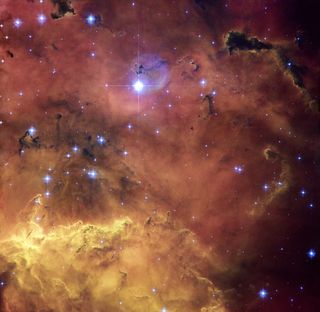
For older Image of the Day pictures, please visit the Image of the Day archives. Pictured: NGC 2467.
Plasma-tics
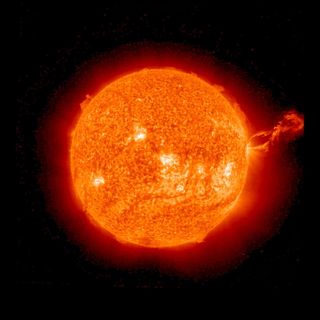
Monday, December 3, 2012: STEREO Ahead spacecraft photographed this solar prominence on October 14, 2012. The prominence consists of a dense mass of electrified gas, known as plasma, held by a magnetic field.
— Tom Chao
Puzzling Evidence
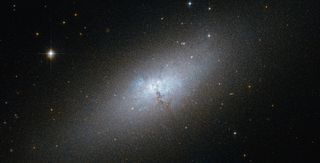
Tuesday, December 4, 2012: NGC 5253, one of the nearest of the known Blue Compact Dwarf (BCD) galaxies, lies about 12 million light-years from Earth in the southern constellation of Centaurus. Blue Compact Dwarf (BCD) galaxies contain very active star-formation regions despite low dust content and comparative lack of elements heavier than hydrogen and helium. BCD galaxies puzzle researchers, as simulations predict far more satellite dwarf galaxies should exist than do. Astronomers call this discrepancy as the Dwarf Galaxy Problem.
— Tom Chao
What the F Ring?
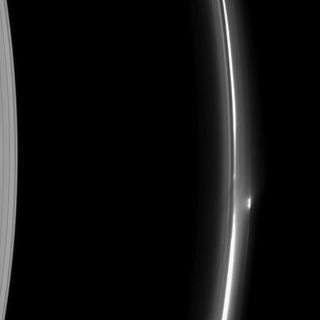
Wednesday, December 5, 2012: A portion of Saturn's F ring displays features believed to be caused by its shepherd moons or with small moonlets within the ring. A bright clump of material floats just outside the main part of the ring (at middle right). The brightness of the clump suggests dusty material. The A ring also glows at the left. Cassini spacecraft obtained this image on June 28, 2012.
— Tom Chao
We Are Young
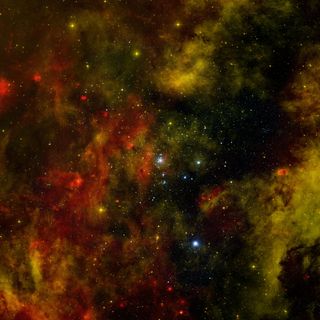
Thursday, December 6, 2012: The star cluster Cygnus OB2 contains hot, massive, young stars, with more than 60 O-type stars and about a thousand B-type stars. NASA’s Chandra X-ray Observatory has been used to detect about 1,700 X-ray sources in the cluster, including about 1,450 thought to be stars. This image combines X-rays from Chandra (blue) with infrared data from NASA’s Spitzer Space Telescope (red) and optical data from the Isaac Newton Telescope (orange). Cygnus OB2 lies only about 5,000 light years from Earth, the closest massive star cluster. Image released Nov. 7, 2012.
— Tom Chao
This Could Be the Last Time
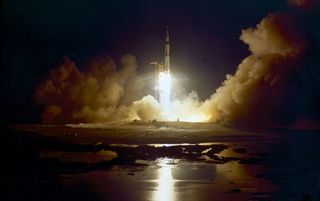
Friday, December 7, 2012: Forty years ago, on Dec. 7, 1972, the final NASA mission carrying astronauts to the moon, Apollo 17, launched from Cape Canaveral, FL. The crew consisted of mission commander Eugene A. Cernan, lunar module pilot Harrison H. Schmitt, and command module pilot Ronald E. Evans. The Lunar Roving Vehicle assisted with collecting 257 pounds (117 kilograms) of lunar samples. The mission concluded on December 19, 1972.
— Tom Chao
The Sun Is a Miasma of Incandescent Plasma
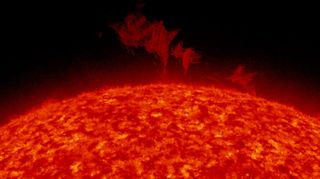
Monday, December 10, 2012: A mass of plasma floated up and danced along the top of the sun before breaking off into space, Nov. 19-21, 2012. Unseen magnetic forces controlled the material’s movement. Image obtained by the Solar Dyamics Observatory.
— Tom Chao
Get the Space.com Newsletter
Breaking space news, the latest updates on rocket launches, skywatching events and more!
Reflections in a Golden Eye
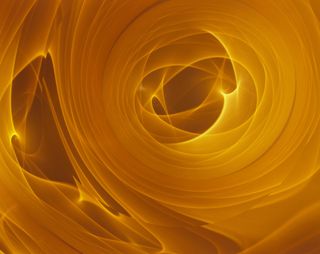
Tuesday, December 11, 2012: This intriguing image does not depict a deep-space scenario, nor a microscopic terrestrial subject. Rather the shimmering light whorls are reflection patterns of a gold-plated spare mirror of ESA’s XMM-Newton X-ray space telescope. XMM-Newton space telescope, launched in 1999, carries 3 X-ray telescopes and an optical monitor, the first flown on a X-ray observatory.
— Tom Chao
A Shooting Star Across the Sky
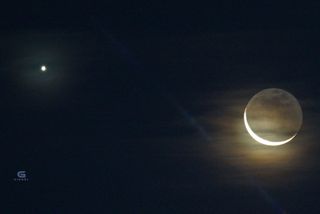
Wednesday, December 12, 2012: Astrophotographer Greg Diesel Walck was aiming his camera at a rising crescent moon and Venus when a Geminid meteor conveniently flew through the shot. The photo was taken in Currituck, NC, on Dec. 11, 2012.
— Tom Chao
You've Got to Take the Moon From the Trees
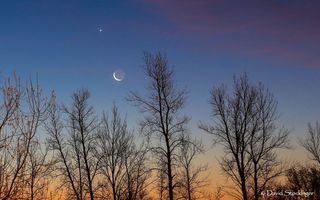
Thursday, December 13, 2012: Astrophotographer David Stockinger caught a night sky photo on Dec. 11, 2012. He writes: "I took this photo of the moon/Venus conjunction this morning on my way to work in the -4 degree weather!"
— Tom Chao
Will You Come Again? It's Hard to Say
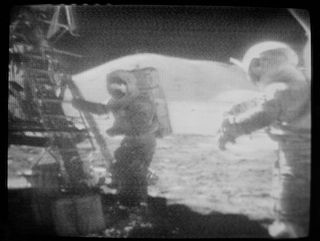
Friday, December 14, 2012: Apollo 17 astronauts Harrison H. Schmitt (left) and Eugene A. Cernan return to the lunar module (LM) at the end of the 3rd extravehicular activity (EVA) on the moon, Dec. 13, 1972. Forty years ago, on Dec. 14, 1972, the LM ascent stage carried the two astronauts from the moon’s surface to rendezvous with Ronald E. Evans in the Command and Service modules for the return to Earth. Apollo 17 marked the last time humans explored the moon (to date). This black and white reproduction was taken from a color television transmission made by the color RCA TV camera mounted on the Lunar Roving Vehicle.
— Tom Chao
Join our Space Forums to keep talking space on the latest missions, night sky and more! And if you have a news tip, correction or comment, let us know at: community@space.com.

Space.com is the premier source of space exploration, innovation and astronomy news, chronicling (and celebrating) humanity's ongoing expansion across the final frontier. Originally founded in 1999, Space.com is, and always has been, the passion of writers and editors who are space fans and also trained journalists. Our current news team consists of Editor-in-Chief Tariq Malik; Editor Hanneke Weitering, Senior Space Writer Mike Wall; Senior Writer Meghan Bartels; Senior Writer Chelsea Gohd, Senior Writer Tereza Pultarova and Staff Writer Alexander Cox, focusing on e-commerce. Senior Producer Steve Spaleta oversees our space videos, with Diana Whitcroft as our Social Media Editor.